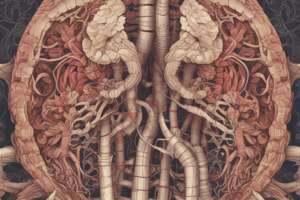Podcast
Questions and Answers
What is the primary function of the cilia in the trachea?
What is the primary function of the cilia in the trachea?
- To propel mucus and debris away from the lungs (correct)
- To support the walls of the trachea
- To move air in and out of the lungs
- To aid in the digestion of food
What is the purpose of the C-shaped rings of hyaline cartilage in the trachea?
What is the purpose of the C-shaped rings of hyaline cartilage in the trachea?
- To filter the air we breathe
- To support the walls of the trachea and keep it open (correct)
- To allow for the expansion of the esophagus
- To provide flexibility to the trachea
Where do the main bronchi plunge into the lung?
Where do the main bronchi plunge into the lung?
- Into the medial depression of the lung (correct)
- Into the thoracic cavity
- Into the base of the lung
- Into the apex of the lung
What is the term for the open, superior portion of the lung?
What is the term for the open, superior portion of the lung?
What is the area in the thoracic cavity that houses the heart and other organs?
What is the area in the thoracic cavity that houses the heart and other organs?
What is the term for the process of propelling mucus and debris away from the lungs?
What is the term for the process of propelling mucus and debris away from the lungs?
What is the amount of air that can be forcefully exhaled after a tidal expiration?
What is the amount of air that can be forcefully exhaled after a tidal expiration?
What is the total amount of exchangeable air in healthy young men?
What is the total amount of exchangeable air in healthy young men?
What is the amount of air that remains in the lungs after the most strenuous expiration?
What is the amount of air that remains in the lungs after the most strenuous expiration?
What is the volume of air that enters the respiratory tract but does not reach the alveoli?
What is the volume of air that enters the respiratory tract but does not reach the alveoli?
What happens when the oxygen supply in the blood is getting low or blood pH is falling?
What happens when the oxygen supply in the blood is getting low or blood pH is falling?
What is the primary factor that modifies respiratory rate and depth?
What is the primary factor that modifies respiratory rate and depth?
What is the term for the amount of air that can be taken in forcibly over the tidal volume?
What is the term for the amount of air that can be taken in forcibly over the tidal volume?
What is the volume of air moved into and out of the lungs with each breath during normal quiet breathing?
What is the volume of air moved into and out of the lungs with each breath during normal quiet breathing?
What is the result of hyperventilation on blood pH?
What is the result of hyperventilation on blood pH?
What happens when carbon dioxide accumulates in the blood?
What happens when carbon dioxide accumulates in the blood?
What is the role of the hypothalamus in breathing?
What is the role of the hypothalamus in breathing?
What is the result of decreased oxygen levels in the blood?
What is the result of decreased oxygen levels in the blood?
What is the main benefit of quitting smoking for people who have been smoking for many years?
What is the main benefit of quitting smoking for people who have been smoking for many years?
What is the leading cause of cancer deaths worldwide?
What is the leading cause of cancer deaths worldwide?
What is the primary purpose of bronchodilator inhalers in treating COPD?
What is the primary purpose of bronchodilator inhalers in treating COPD?
What is a common symptom of lung cancer that occurs when the disease is advanced?
What is a common symptom of lung cancer that occurs when the disease is advanced?
What is a possible indication of lung cancer spreading to other parts of the body?
What is a possible indication of lung cancer spreading to other parts of the body?
What is a key difference between COPD and lung cancer?
What is a key difference between COPD and lung cancer?
What is a common underlying factor that predisposes individuals to acute secondary bacterial infections of the bronchi?
What is a common underlying factor that predisposes individuals to acute secondary bacterial infections of the bronchi?
What is a characteristic of chronic bronchitis?
What is a characteristic of chronic bronchitis?
What is a consequence of the destruction of ciliated epithelium in chronic bronchitis?
What is a consequence of the destruction of ciliated epithelium in chronic bronchitis?
What is a characteristic of emphysema?
What is a characteristic of emphysema?
What is a potential complication of chronic bronchitis?
What is a potential complication of chronic bronchitis?
What is a result of edema and inflammatory changes in chronic bronchitis?
What is a result of edema and inflammatory changes in chronic bronchitis?
Flashcards are hidden until you start studying
Study Notes
Trachea Structure and Function
- The trachea is reinforced with C-shaped rings of hyaline cartilage, making it fairly rigid.
- The open parts of the rings allow the esophagus to expand anteriorly when swallowing, while the solid portions support the trachea walls and keep it patent.
- The trachea is lined with ciliated mucosa that propels mucus, loaded with dust particles and other debris, away from the lungs and towards the throat.
Main Bronchi
- The right and left main bronchi are formed by the division of the trachea.
- Each main bronchus runs obliquely before plunging into the medial depression of the lung on its own side.
- The right main bronchus is wider, shorter, and straighter than the left.
Lungs
- The lungs occupy the entire thoracic cavity, except for the mediastinum, which houses the heart, great blood vessels, bronchi, esophagus, and other organs.
- The narrow, superior portion of each lung is the apex, which is just deep to the clavicle.
- The broad lung area resting on the diaphragm is the base.
Respiratory Volumes and Capacities
- Tidal volume: approximately 500 ml of air moved into and out of the lungs with each breath.
- Inspiratory reserve volume: 2100-3200 ml of air that can be taken in forcibly over the tidal volume.
- Expiratory reserve volume: approximately 1200 ml of air that can be forcibly exhaled after a tidal expiration.
- Residual volume: approximately 1200 ml of air that remains in the lungs after the most strenuous expiration, allowing gas exchange to continue.
- Vital capacity: the sum of tidal volume, inspiratory reserve volume, and expiratory reserve volume, typically around 4800 ml in healthy young men.
Other Respiratory Concepts
- Dead space volume: approximately 150 ml of air that enters the respiratory tract but never reaches the alveoli.
- Volition: voluntary control of breathing is limited, and the respiratory centers can override conscious control when oxygen supply is low or blood pH is falling.
- Emotional factors: modify the rate and depth of breathing through reflexes initiated by emotional stimuli acting through centers in the hypothalamus.
- Chemical factors: levels of carbon dioxide and oxygen in the blood are the most important stimuli that modify respiratory rate and depth.
- Hyperventilation: blows off more carbon dioxide, decreasing the amount of carbonic acid, and returning blood pH to normal range.
- Hypoventilation: allows carbon dioxide to accumulate in the blood, bringing blood pH back into normal range when it becomes slightly alkaline.
Respiratory Diseases
- COPD: can be treated with medicines, oxygen, and pulmonary rehabilitation, but is not curable; main treatments include inhaled medicines that open and reduce swelling in the airways.
- Lung cancer: leading cause of cancer deaths worldwide; risk increases with length and number of cigarettes smoked; quitting smoking significantly lowers the chances of developing lung cancer.
- Symptoms of lung cancer: may include a new cough, chest pain, coughing up blood, hoarseness, shortness of breath, and wheezing.
- Acute bronchitis: secondary bacterial infections of the bronchi, often preceded by common cold or influenza.
- Chronic bronchitis: progressive inflammatory disease resulting from prolonged irritation of the bronchial epithelium, often a consequence of cigarette smoking and chronic exposure to airborne irritants.
Studying That Suits You
Use AI to generate personalized quizzes and flashcards to suit your learning preferences.





